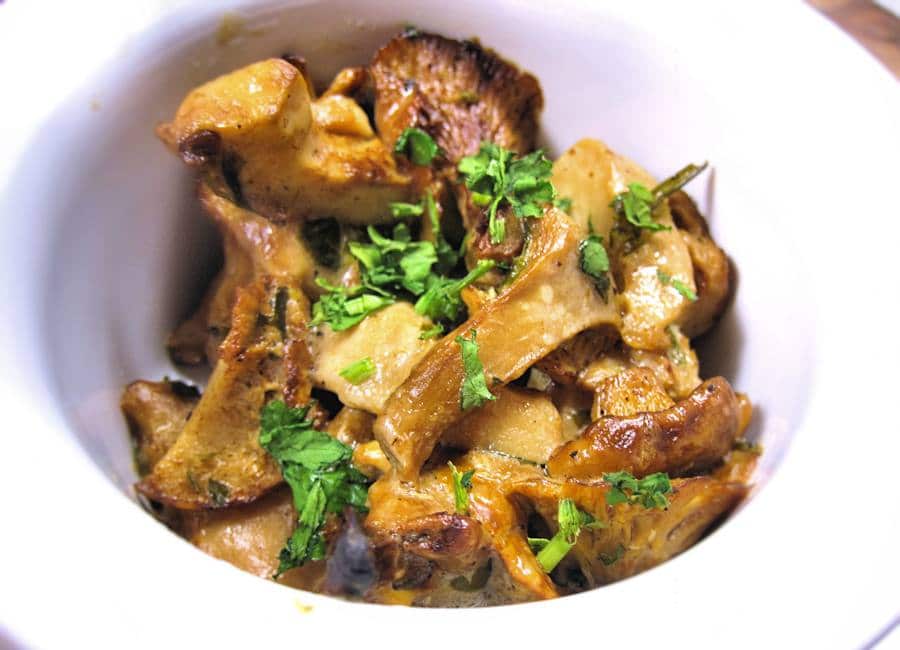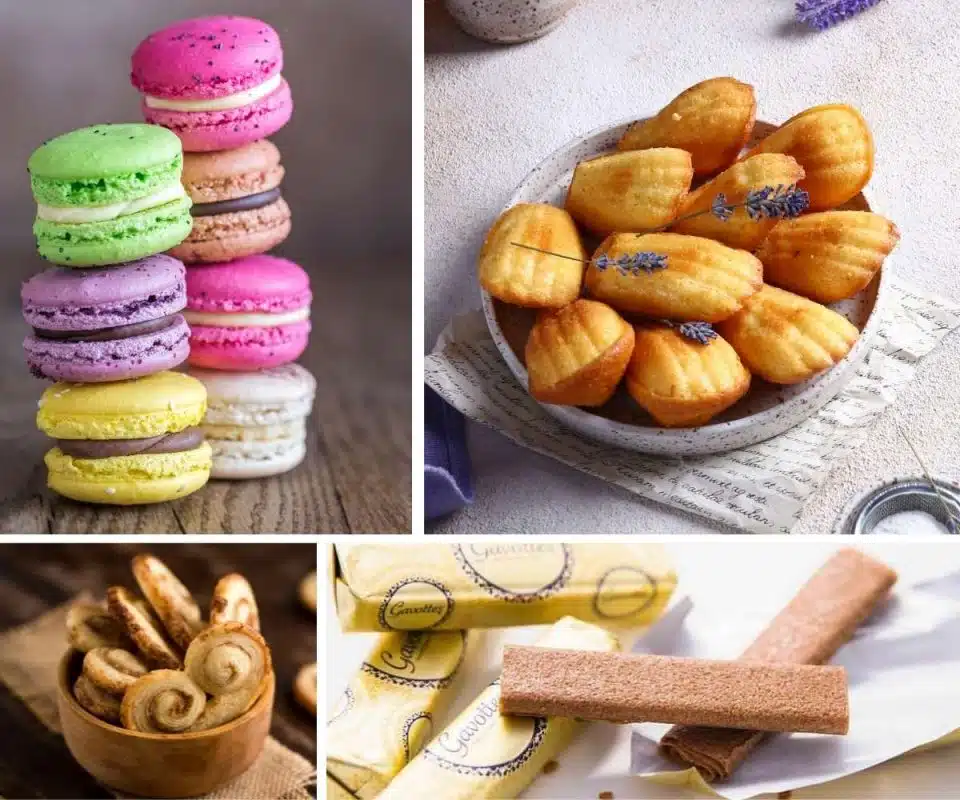Unmissable French Christmas Food and Drinks

Even though Christmas food is less and less linked to religious traditions in France, the French are still accustomed to having a big, fancy dinner late on Christmas Eve. And not only is it the biggest gastronomic feast of the year, it also has a name: Le Réveillon, meaning something like “The Awakening”.
In the past, Christian traditions dictated that on this night, people should wait until after Midnight Mass to start eating, hence the name of the dinner since it kept people awake until the wee hours of the morning. While a number of families still follow this rule, most French families now gather in the evening of the 24th and start dinner at a more regular time, forgoing church. Alternatively, they may gather on the 25th, or both.
Now, a word of advice: if you get invited to a typical French Christmas dinner, you’d better come with an empty stomach. There is always tons of delicious food, and you’ll be staying at the table for at least three hours on the table, usually longer!
The feast typically starts with a bunch of appetizers, followed by the main course (sometimes two), a platter of cheese, of course, and a variety of desserts -up to thirteen of them!. Sparkling wine flows in abundance, along with other liqueurs and spirits. Here is what to expect for a classical Christmas meal in France. Santé!
APPETIZERS
Oysters

The queen of Christmas appetizers, and possibly the lightest dish you will have all night! Served raw in their shells with a hint of lemon, sometimes with toasted bread and butter. On more rare occasions, they can be slightly cooked in the oven with a slice of cheese on top and served warm. Usually served with a crisp white wine.
Foie gras

The king of Christmas appetizers, traditionally spread on toasted bread, sometimes with a hint of fig marmalade or caramelized onion, and a glass of sweet wine like Sauternes or Montbazillac.
For vegans, there are some alternatives to foie gras in the form of plant-based pâtés, such as “Faux gras”, which does a great job of imitating the taste and texture of foie gras, but with no animal ingredients.
Smoked Salmon

Another holiday classic, the French like to serve smoked salmon in one of two ways: either on toasted bread with butter and lemon, sometimes with capers, or with sour cream spread on blinis, which are tiny buckwheat pancakes, originally from Greece.
Caviar

Blinis have another use: caviar. Less common due to its prohibitive price, caviar (the eggs of sturgeon fish) is served on smaller portions of blinis. Most families purchase what some call the “fake caviar”, made with the much more affordable lumpfish eggs.
Escargots (Snails)

The famous French snails! We need to tackle a myth here: French people don’t eat snails all the time. In fact, the holiday season is one of the rare occasions of the year when escargots are on the menu. The big snails, which measure about 1.7 inches across, are cooked in their shell, then stuffed with a mix of butter, parsley, and salt. Not for everybody’s taste, but a delicious treat for some.
More Seafood

Apart from these five classics, the French often have more seafood for appetizers, which typically includes langoustines (scampi), and scallops in a cream sauce.
And more charcuterie

Next up we have pâté en croûte, which is a combination of ground meat and organ meats, encased in a pastry crust and cooked in the oven. It is served in small portions as an appetizer.

Our final appetizer is terrine, named after the dish it is cooked in, which combines layers of duck, bacon, pork, herbs, and spices. It is served on a slice of bread with mustard and a pickle. Depending on the region, you may find other local versions as well.
MAIN COURSES – MEATS:
Small Turkey Stuffed with Chestnut

Yes, you read that right. The traditional way to eat turkey for this special time of the year is with chestnut, although it needn’t be a stuffing; it can also be placed around the bird, as an ornament. Note that French turkeys are significantly smaller than the ones eaten in the US for Thanksgiving.
Le Chapon

Chapon (capon) is the most common alternative to turkey. But what is it? Nothing more than a castrated rooster – a process that is supposed to make it more tender and improve its flavor. Ironically, this dish is sometimes served with nuts. Pun intended.
Confit de Canard

French people’s love for duck does not end with foie gras. Another favorite for Christmas (and all year long, to be fair) is confit de canard.
The meat of an entire duck is salted, slowly roasted for several hours, then stored for months in hermetic jars, with the fat from the duck acting as the perfect preservative. And when there is no confit, it can be magret de canard instead, which is basically duck breasts barely cooked to keep the meat very red, served with a sweet sauce of cranberry or orange.
And more poultry

If it’s not turkey or chapon or duck on your table, you may find either guinea fowl, pheasant, quail, or goose. Let’s be clear: these are not commonly eaten by the French – only during the Holiday season. Just as with turkey, these various birds can be roasted and served with a similar side of chestnuts and/or sauce.
Roasted Beef

You may have noticed that until now, it’s all about birds. Well, for those who enjoy red meat, good old roast beef is also quite traditional for Christmas, with roast potatoes on the side. Also eaten throughout the year, this might not be the most Christmassy meal, but it’s a solid favorite for some.
Wild Game

The French are not big consumers of wild game. However, you may well find some on a few people’s tables at Christmas. Popular choices are venison, wild boar, or sometimes hare, all of which are usually slow-cooked, marinated in red wine, and served with gravy. Rich and delicious.
Lobster

Lobster (particularly blue lobster) is traditionally served for Christmas dinner, but the hefty price requires a certain budget. For that reason, it is far less common than meaty dishes. Given that there is usually seafood for appetizers, most people like to switch to meat for the main course.
MAIN COURSES – EVERYTHING NON-MEATY:
Gratin Dauphinois

Finally, a typical holiday dish that does not involve meat, fish, or seafood! The gratin dauphinois is a combination of layers of sliced potato, cream with garlic, and sliced Gruyère cheese. It is a very tasty and filling dish, which can be served as a side for the meat, or by itself with a little bit of lettuce on the side.
Grilled Mushrooms

We are talking about wild mushrooms here, not the white, boring champignon de Paris that you can find at any supermarket.
In the countryside, French people often collect wild mushrooms by themselves in the wood, or simply buy them fresh at the farmers’ market. Typically prepared with a dash of white wine and a bit of garlic, they are a great side dish with any meat, and also go great with the gratin dauphinois mentioned above.
Spinach Soufflé

While the chocolate soufflé is probably better known internationally, the French also enjoy savory soufflés. This one, filled with spinach and a bit of cheese, is a holiday classic, and a relatively light and healthy option too.
Haricots Verts

The healthiest item on the table: fresh green beans cooked in water, with a dash of butter and garlic for taste and texture. That’s it.
CHEESE

A traditional French meal always features a cheese platter. While there isn’t really a “Christmas cheese”, you will normally find Camembert, Brie, aged Comté, probably some goat cheese and blue cheese, or maybe a rich Brillat-Savarin with truffles. For an authentic French cheese board, you’ll need at least four different varieties.
DESSERTS
Bûche de Noël

This is, without a doubt, the most emblematic Christmas dessert. Bûche de Noël literally means Christmas log, because it mimics a tree branch. Known in English as yule log, it is merely a rolled genoise cake filled with buttercream and decorated with mushroom-shaped meringue.
The most creative (and talented) bakers also create small characters and birds out of marzipan to decorate the log. While the buttercream filling is traditionally made with chocolate, you can also use coffee, toffee, or fruity cream.
Marrons Chauds

These roasted hot chestnuts may not make it to Christmas lunch or dinner, but they are very popular as a snack during the holiday season, mostly sold by street vendors who roast them on the spot and serve them in paper bags, or in newspaper.
Marrons Glacés

While the name means “iced chestnuts”, marrons glacés are not quite the opposite to “hot chestnuts”, as the fruits are cooked in both cases, albeit differently. Glacés refers here to the sugar glazing that surrounds the chestnuts. They are served individually on tiny paper cups at the end of a typical Christmas meal, along with coffee or tea.
Pain d’épices

The French equivalent of gingerbread, particularly popular in the east and north of France. This sweet bread is typically aromatized with cinnamon, cardamom, almonds, and honey.
The 13 Desserts

Before you gasp, let me state that this is not as decadent as it seems. This tradition from Provence, in the south of France, is a direct reference to the last dinner of Jesus and his 12 apostles: one portion of dessert for each. Today, it is still common to follow this tradition to finish the Réveillon.
While the individual desserts can vary, there is usually a combination of different nuts, fruits (fresh, dried and candied), and regional specialties such as nougat from Montélimar, calissons from Aix, and the traditional olive oil cake known as pompe à l’huile (literally “oil pump”). The idea is not to eat 13 desserts per person, rather share them!
DRINKS
Sparkling Wine

Christmas is a time of celebration, and when it comes to drinks, celebration = sparkling wine. Of course, champagne is the most famous and the most commonly served, but other varieties such as Vouvray or Blanquette de Limoux are also holiday classics. Sparkling wine goes with the appetizers, served before the main course.
Kir Royal

Another holiday classic, made of champagne and blackcurrant liquor (although some prefer cherry liquor as well). A nice cool Kir Royal goes perfectly with appetizers and with desserts.
Blackcurrants are popular fruits in France and blackcurrant liquor is a must-try, but also blackcurrant syrup, a favorite among kids.
Mulled Wine

Known as glühwein in Germany and vin chaud in France, this mixture is typical from the east of France, particularly the once-German region of Alsace. Mulled wine can be made with either red or white wine, slowly heated up together with star anise, cinnamon sticks, cloves, brown sugar (or honey), orange and lemon zest, and a hint of black pepper. The result is a flavorful, slightly spicy, warming drink that is typical of the holiday season, and is usually found at Christmas markets.
By the way, while the main holiday meal is undoubtedly Christmas Eve, there is still a large lunch to come on Christmas Day, when other parts of the family meet. The feasting can go on for several days until all the parents, grandparents, cousins and other relatives have visited; there are always plenty of leftovers. And before you know it, it’s December 31, time for another huge dinner, followed by another huge lunch on January 1. There’s simply no rest!
Related: 50 Popular French Dishes
Related: 40 Popular French Desserts

Related: Popular French Cookies


